How to Make a Hospital Management Software

Key takeaways
- Find out how hospital management systems can help optimize healthcare operations.
- Discover the modular types of hospital management software and how their functionality differs depending on the needs.
- Learn about the core features of a healthcare management system and how they can affect the efficiency of a medical facility at all stages.
- Explore the benefits of implementing hospital mangement software, including streamlined workflows and increased revenue.
- What are the differences between custom and out-of-the-box hospital management systems? Let’s compare them to understand which option suits your needs most.
- Gain insight into one of the best hospital management software available on the market and figure out what makes these systems stand out.
- Learn the main steps of developing customized hospital management software.
- Understand the factors influencing the cost of developing a hospital manegement system, such as desired features, customization requirements, and ongoing maintenance.
Qualified staff forms only one part of a successful health facility, while a well-established, automated organization management process makes the other part. Taking into account the complexity of any hospital ecosystem, the whole functioning of the entity is impossible without a hospital management information system.
In this article, we will consider the HSM (hospital management software), its most important features, and development tips, and finally share valuable tips on how to create a hospital management software.
Hospital management software: a brief overview
HMS encompasses a rather broad concept, so, for clarity, we will explain what this means. A hospital management system is a standalone or cloud-based web medical management system that accumulates and integrates data from all departments to automate the institution’s daily internal processes.
The need for a powerful instrument that can streamline the majority of hospital operations, cut costs, and improve employee productivity is growing by leaps and bounds. According to the research conducted by Research and Markets, the global market for healthcare workforce management Systems is projected to record 13.6% CAGR and reach US$7 billion by the end of 2030.
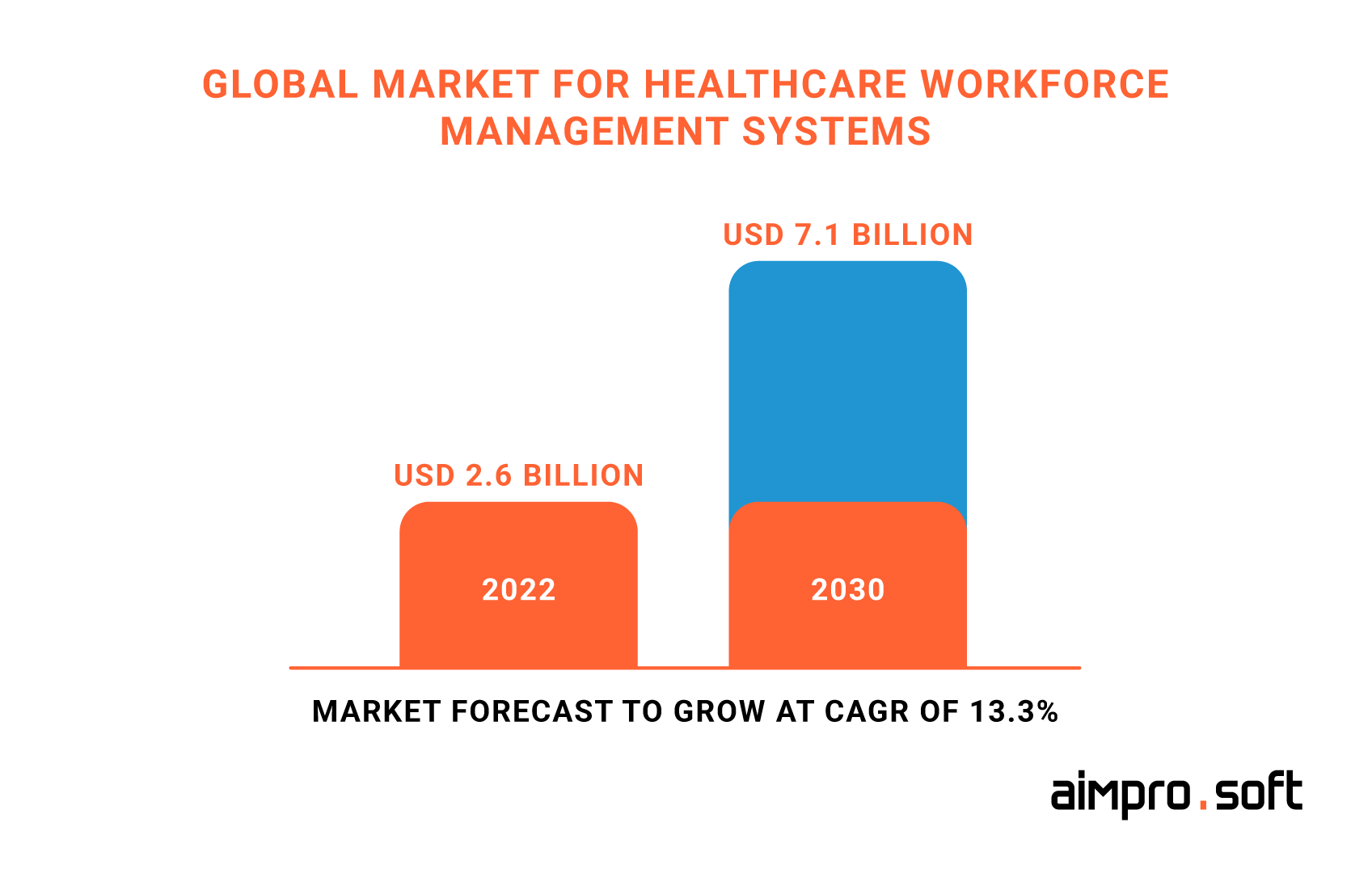
Global hospital software management systems market growth to 2029. Source: Research and Markets
HMS is aimed at facilitating the work of hospital staff, including interactions with patients. It helps with:
- automation of routine tasks;
- improved communication and coordination of staff;
- achieving a patient-centered approach;
- material and human resources management;
- supply chain control.
Hospital management systems contain information about:
| Categories | Data |
|---|---|
| Doctors | Schedules, appointments, emergency numbers |
| Staff | Contact numbers, professional information |
| Patients | Confidential personal data, medical history |
| Laboratory results | Test and analysis results |
| Supplies | Medicine and instruments inventory |
| Billing | Hospital and patients spending |
| Insurance | Patient insurance data |
| Statistical reports | All the data analysis and diversified reports |
Module types of hospital management software
The eHospital software can vary from one health organization to another, depending on the functionality it incorporates. However, we have distinguished the five main module types that are used in each HMS. Keep in mind that your system can be a combination of different software modules and include different functionality developed according to your particular needs. Now let’s take a deeper look at them for a clearer understanding.
Operational and tactical systems
Operational systems are known as one of the most common methods for classifying medical information. Its integration gives you an opportunity to distribute information pyramidally, where these systems deal with a certain type of medical information at each level. It allows ensuring reliable and fast operation with data, as well as detecting inconsistencies in the system. Reliable work with information will provide any hospital with the necessary foundation for high-quality work, both with patients and with internal issues.
Administrative and clinical systems
Mandatory for all hospitals, this module of HMS is responsible for providing patient information in the form of reports and statistics. Information is entered into the system when the patient is discharged (retrospective data entry), as well as after medical assistance (to provide details), after which it is sent as a report to the Department of Health (DOH). Keep in mind that the clinical system, which contains electronic patient records (EPRs), is based on the administrative one since administrative information provides different hospital software systems with links.
Subject-based systems
Subject-based systems, by which we mean Electronic Health Records (EHR) or Electronic Medical Records (EMR), are used to store patient information digitally. They are mainly used by hospitals to manage and store a complete digital history of patients. Compared to paper-based records, EHR and EMR help avoid data duplication since all information is stored in one file that can be modified over time. Usually, these modules are widespread in clinics with hospital management software.
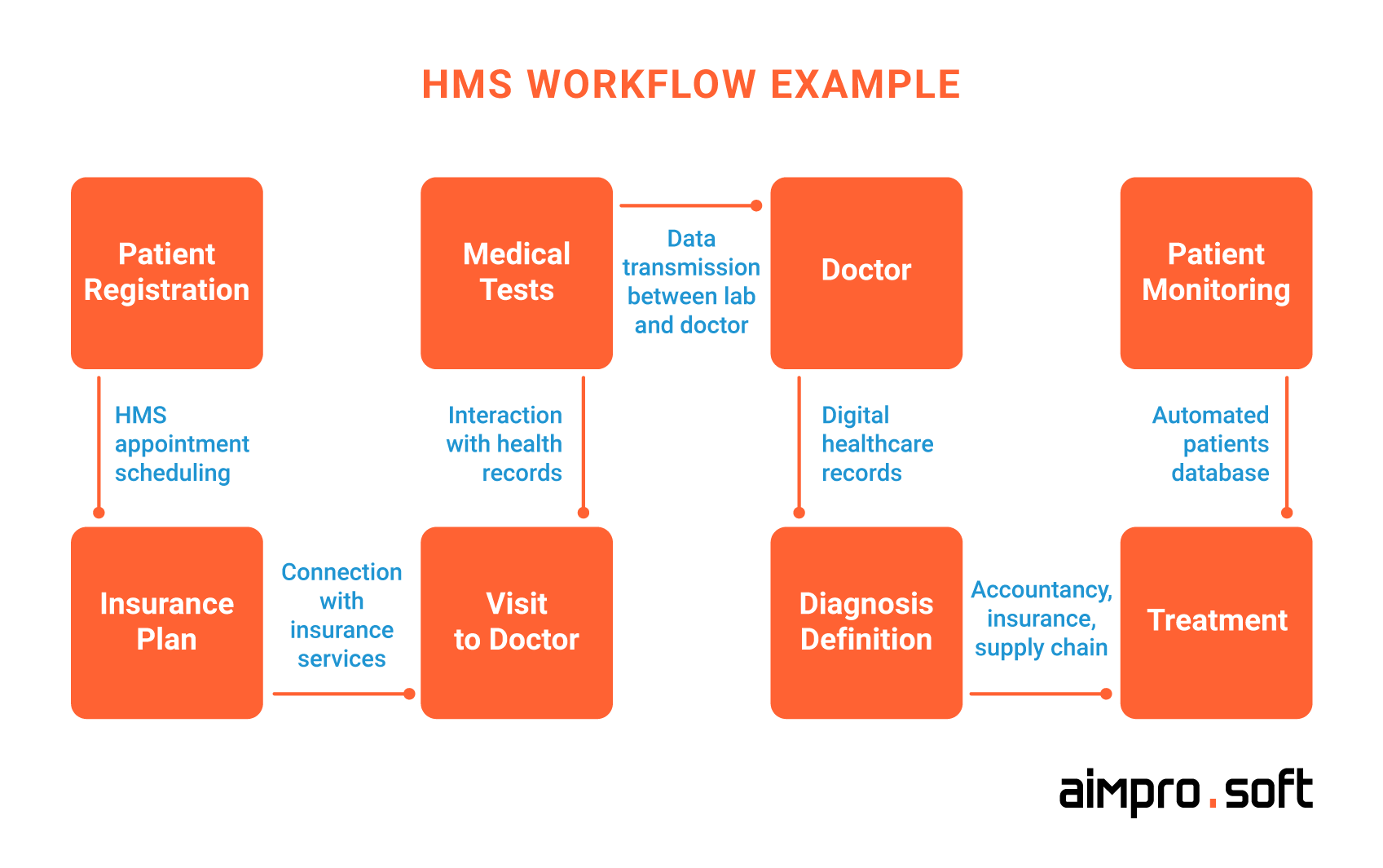
Example of HMS workflow
Task-based systems
Task-based systems are designed for the optimal categorization of working tasks. An intelligent representative of this type of system will automatically prioritize and distribute tasks between staff based on the current hospital situation. Such modules focus on certain tasks, e.g., admissions/discharge or transfer to an operating theater.
When implementing such a system, keep in mind that it works worse than its alternatives, like subject-based ones, due to the increased risk of data duplication, which affects the speed of the system, the optimization of disk space, and the nature of storage of data arrays. The risk arises because of the peculiarities of this HMS component, which lies in the fact that the same subject undergoes several different tasks, and basic data, such as name and address, is collected every time.
Billing or Financial systems
Billing systems are responsible for monitoring and managing the finances of the hospital. Patient costing is monitored thanks to the tagging of different outputs from clinical management systems with the corresponding prices. The lion’s share of costing is carried out by assessing the cost distribution of previous years. Given all of the above, billing systems are an integral part of hospitals for optimal financial performance.
HMS features
HMS is created to ensure the effectiveness of medical facilities at all stages. Accordingly, the functionality of such systems should cover a wide range of tasks. Let’s look at the main features you will need to build a hms hospital management system:
| Area of the system | Description |
|---|---|
| Patient registration and scheduling | Acceleration and simplification of the patient registration process by automating call processing and filling out medical forms. Subsequently, the patient has the opportunity to make an appointment with the doctor from anywhere at the desired time, and the doctor can monitor the schedule of patients. Providing a convenient patient system is the basis for the formation of the rest of the patient-interaction functionality. |
| Financial management | Monitoring the budget and various financial transactions, which include accounts, taxes, and cost. HMS should automate the total price for hospital services and keep a payment history for each patient. At the same time, patients need to see a list of prices for any service before payment. A valuable advantage of financial management automation will be the analysis of the financial situation of the hospital and the preparation of a correction for the strategy to improve it. |
| Inventory management | Tracking the number of items in stock to control the availability of medical materials. Using this feature, employees can track the supplies and calculate the necessary time for the next delivery. Also, the hospital computer programs help control the expiration date of medicines. |
| Laboratory management | Thanks to email notifications or messages in communication channels, clinic staff, and patients can quickly find out about test results. Often, the speed of their receipt directly affects the successful outcome of treatment. |
| Data reports and statistics | A properly configured system allows you to create statistical reports about patients, doctors, budgets, and many other things with a couple of mouse clicks. This data can be a valuable source of information for successful institution management and further development. |
| Support management | In view of the fact that the management software is sufficiently comprehensive, the support feature will become extremely useful for both employees and patients. The helpdesk will serve the former as a basis for working with all the necessary system tools, while the latter will be able to receive continuous care, for example, in the form of automatically created personnel calendars. |
Now that you have an idea of the most mandatory features of any HMS, let’s dwell on the advantages of hospital system management for healthcare facilities.
Read in our article how to develop a medical software properly to keep personal information HIPAA compliant.
Benefits of implementing clinic management software
Automated processes
Clinics are known for their complex daily processes. The main benefit of implementing dispensary management system software is the work processes automation and optimization. By eliminating manual steps, the risks of human error decrease, and productivity and collaborative processes improve so that a health facility gets a lasting competitive advantage. The released labor force allows a more flexible allocation of human resources and even saves on the number of required employees for particular tasks.
Reduced workload
Medical workers are constantly confronted with pressure, which can quickly burn them out. HMS allows reducing stress and workload by automating processes such as paperwork and inventory management — areas where staff spend a lot of time on a daily basis. Thanks to that, hospital staff become more productive and engaged.
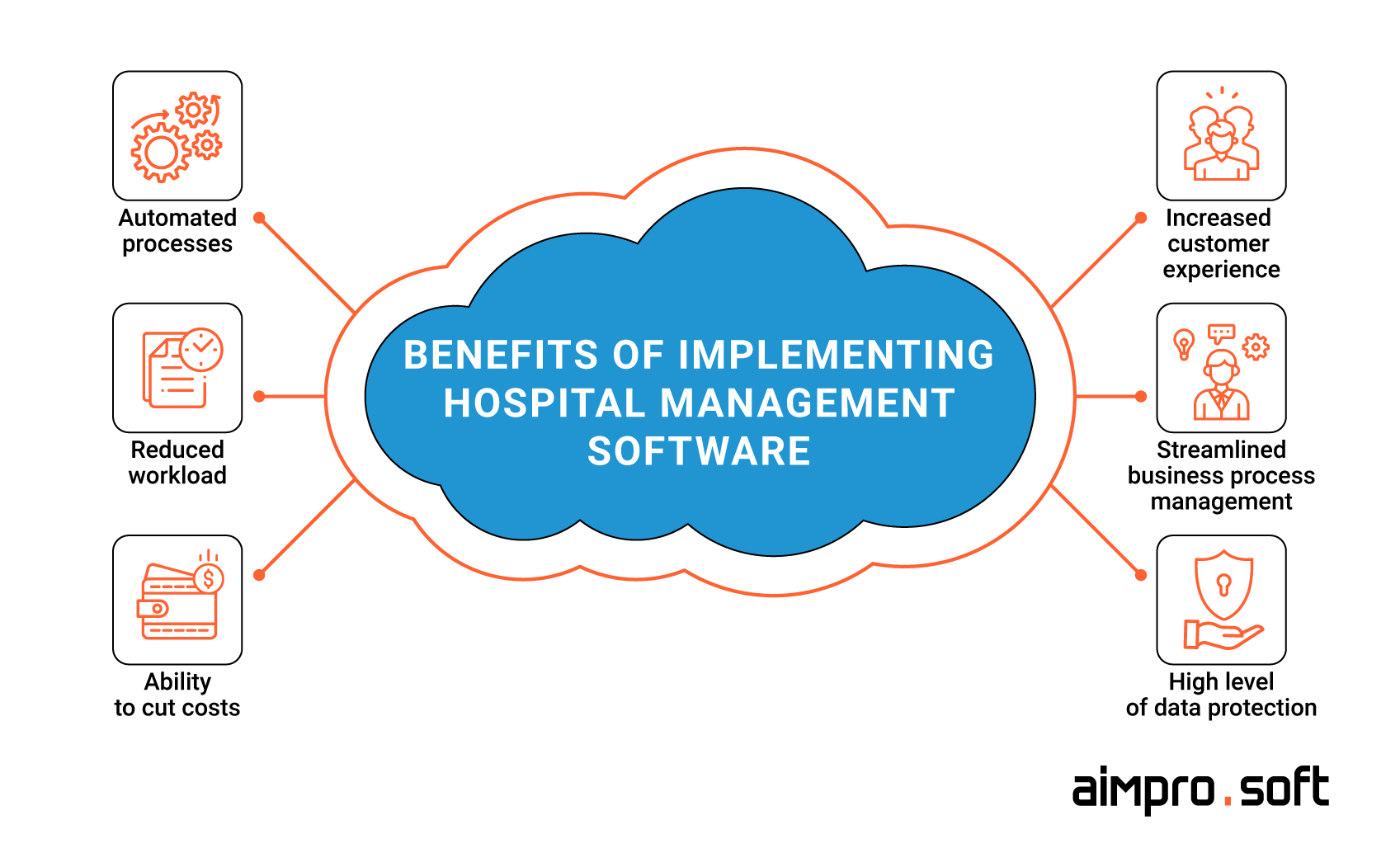
Main benefits of implementing hospital management systems
Reduced costs
According to statistics, more than 23% of all spending in US hospitals falls on administrative costs. The decision to create a hospital management system can help prevent some of these expenses by automating bureaucratic processes such as inventory and laboratory management, as well as patient registration. By reducing manual paperwork and streamlining all these processes, hospitals can save time and reduce staffing requirements, leading to cost savings.
Moreover, HMS collects and analyses massive volumes of data about patients, treatments, outcomes, and operational processes. This information can be used by hospitals to find cost-cutting opportunities, optimize resource allocation, and apply evidence-based practices. Data-driven decisions can assist hospitals in identifying inefficiencies, eliminating unnecessary expenditures, and improving overall cost-effectiveness.
Increased customer experience
With the introduction of HMS in the hospital, the customer experience will improve by default. As a result, the processes of registration, appointments, monitoring the doctors’ schedules, obtaining test results, and much more are digitized. Separately, patients will appreciate the ability to control the billing process, including the history of payments and displayed prices for various services, as well as access to a portal via web and mobile devices.
Strategic development
Having an HMS in a clinic makes it easier to manage and direct business processes within the medical facility. This comes up from a large list of management and analysis tools that you get with HMS. They provide great support in planning and implementing strategic decisions to improve company productivity and finances. Without HMS, it becomes significantly harder to see a complete business picture and navigate in a bureaucratic fog.
Data security
In the medical field, it has long been established that hospitals that use manual management systems are more prone to data leaks and information thefts than digital ones. A full-fledged HMS keeps all information safe from unauthorized access right up to the last kilobit. The access-control system eliminates the probability of an error that raises the chances of access to vulnerable information by an unauthorized person, which is the main reason for the widespread occurrence of HMS in recent years.
Understanding functional and non-functional requirements in hospital management systems
To make a hospital management system software, you should clearly understand what processes you want to establish, what functions the system will support, and clearly define its users. All the determined requirements for the system are fixed in SRS (Software Requirements Specification) to achieve a common vision of the product with your hospital software development company and lay down the optimal set of functions. Accurate estimation is also formed on an SRS basis. It can be drawn for you by a specialized company or an IT vendor that provides software development on a turnkey basis.
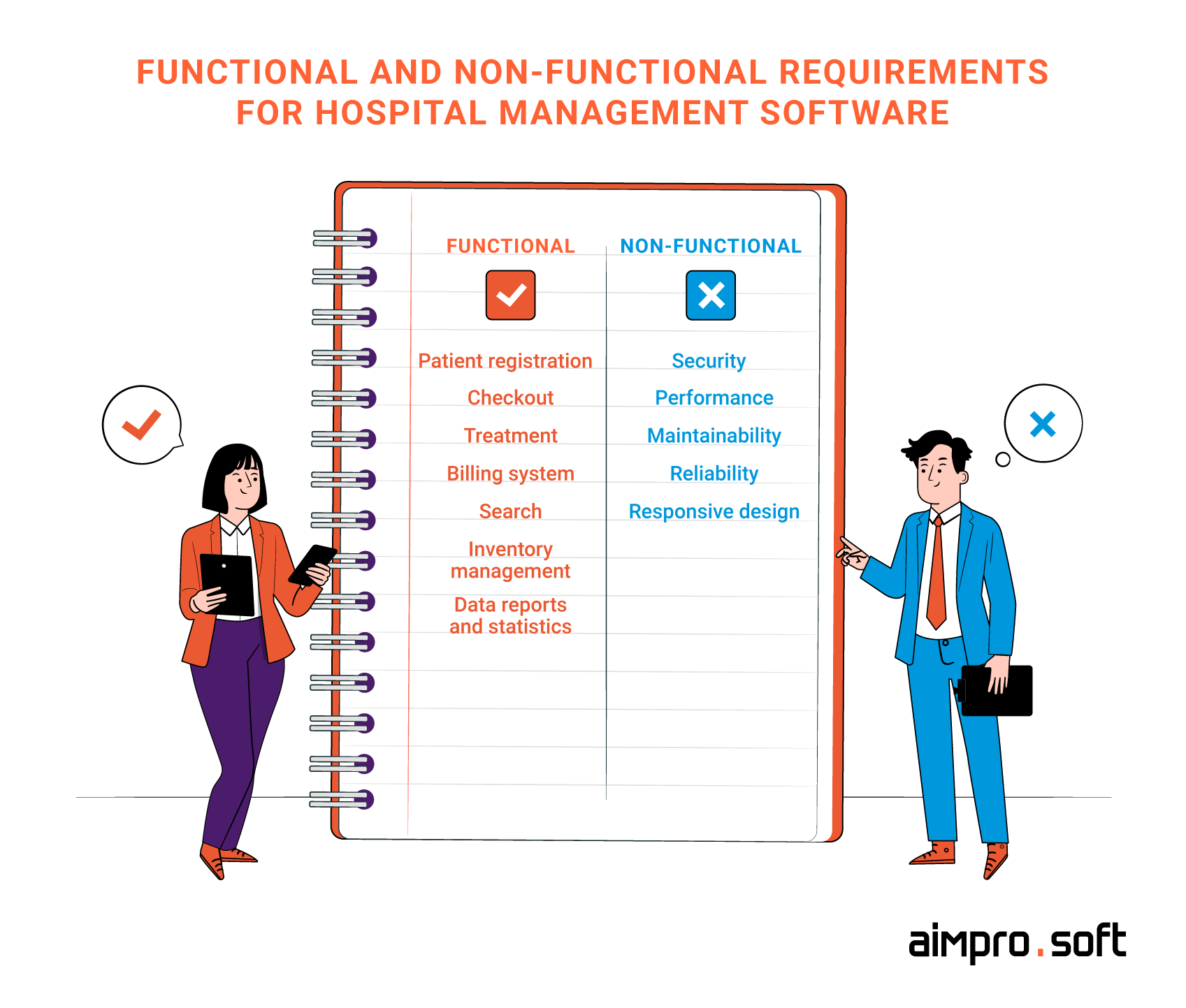
Functional and non-functional requirements for hospital management software
The HMS requirements are divided into functional and non-functional. We’ll mention here the basic ones as the list may vary and expand according to the hospital’s goals.
Functional requirements
Patient registration
The patient registration function involves collecting and recording patient information such as name, date of birth, contact details, and health status. It also assigns unique identification numbers to each patient for tracking purposes. This function facilitates effective communication, appointment scheduling, and the creation of electronic medical records.
Checkout
The checkout feature includes archiving and storing all relevant data after the patient is discharged from the hospital. This process ensures that important information about the patient’s stay, treatment, and outcomes is securely recorded and available for use for future treatment.
Treatment
Enables doctors to manage and document all aspects of patient care efficiently. It includes creating and maintaining comprehensive treatment plans, managing tests and prescriptions, securely storing data, and monitoring patient histories.
Billing system
Hospital billing software provides safe and reliable work with finances in the organization. It automatically generates detailed budget data and reports on in-patient, laboratory, and pharmacy services.
Search
The search capability allows you to quickly find the right doctors, patients, and certain information about the services and work of hospitals. Using the search, patients can find out their test results, the cost of services, and the physicians’ working hours, while doctors can obtain data about their patients.
Inventory management
Inventory management saves an organization’s time and money by reducing staff working hours on manual work with the inventory. It also helps control the quantity and quality of available hospital resources, which allows you to plan orders for medical supplies. Thanks to the automatic search and the folder-based structure, the hospital staff can find the missing item in seconds.
Data reports and statistics
This feature provides access to mandatory patient information and makes editing and updating data easy. It allows healthcare professionals to create comprehensive reports and analyze information change trends, facilitating informed decision-making and improving overall patient care.
Non-functional requirements
Non-functional requirements define the efficient operation of HMS and must specify certain criteria the system must comply with. Let’s take them one by one.
Security & Compliance
Security is a critical non-functional requirement of the hospital management software and includes several core components. Patient identification and ‘know your customer’ (KYC) mechanisms often implements to ensure accurate patient identification and authentication. A secure login ID and encrypted password mechanism should also protect access to sensitive information. Data security measures ensure incoming information’s confidentiality, integrity, and availability. It’s also vital to have a clearly defined role & permissions requirements mechanism, which is based on the idea that each user should see and do only what is allowed by the permission system, and all other actions should be blocked.
Another vital aspect is to ensure compliance with the legal framework of the country where the system is used, complying with relevant health regulations and data privacy laws.
Performance
This option includes several key aspects, such as the system’s response time. It must ensure that the system responds quickly within one second of a user request. In addition, the system should support at least 200 simultaneous users, which can vary depending on the organization’s size, and have unlimited capacity for patient registration.
Maintainability
This non-functional requirement concerns the system’s ability to maintain and support it efficiently. Two key points to highlight are error handling and backup capabilities. The system must record all errors that occur, providing valuable information for troubleshooting and improving stability. Additionally, the system should provide automatic and on-demand backups, protecting data from possible loss or corruption. Disaster recovery mechanisms should also be in place to quickly restore the system code infrastructure to a new server if a device is lost or stolen.
Reliability
Reliability is a fundamental non-functional requirement for a medical management system, ensuring that the system is continuously available 24/7. The system must be developed so that it is always available to healthcare experts and authorized users, providing continuous access to critical patient information and functionalities.
Responsive design
Responsive design ensures that the system works well across all devices and browsers, eliminating the need for separate applications for different platforms. With responsive design, medical professionals can access the system seamlessly on desktops, laptops, tablets, and smartphones, facilitating accessibility and improving the user experience.
Custom vs. Out-of-the-box HMS
Disputes about the right choice between custom and out-of-the-box solutions in popularity may compete only with the question of how to create a hospital management software. We’ll cover both topics. But first, let’s dive into the benefits and shortcomings of out-of-the-box solutions.
Out-of-the-box (OOTB) HMS benefits:
- first of all, the cost of ready-made software solutions is traditionally lower than that of custom ones;
- out-of-the-box software is quickly deployed. You can use the system in a pretty short time after the required installation and configuration processes;
- you don’t have to worry about low-quality software — this is a proven solution with a large customer base. It is distributed with QA tests by the manufacturer and support team, ready to answer any question about the product;
Even though software with out-of-the-box functionality offers convenient business management and automation of work processes, it also has disadvantages:
- since needs vary from hospital to hospital, it is impossible to find a single solution to cover all requirements. Therefore, manufacturers aim their product to cover the most popular issues, which makes it difficult to select a solution that covers all the needs of a particular organization;
- ready-made software allows you to save money, but you can’t do it without expenses anyway. To install and configure such a system, you will have to hire a vendor with the corresponding knowledge and expertise, not to mention the necessity of annual licensing for some solutions.
Custom HMS benefits:
Custom hospital management system software development begins after a detailed analysis and selection of the optimal solution for a particular business. Its main advantages are:
- better applicability which is provided by meticulous accounting of customer needs;
- with a custom product, you avoid licensing expansions, which are inevitable in a turnkey alternative;
- if you have custom software, you do not have to wait for an update hoping that necessary capabilities will appear because you decide which functionality you need and discuss the terms directly with the vendor’s development team;
- having functionality that competitors do not have, you stand out qualitatively in the market. This, in turn, allows you to increase sales and market share.
As for the shortcomings of custom solutions, it is worth highlighting the following:
- they have a higher initial cost being developed specifically for a particular business. However, it pays off over time since you do not need to pay for a license, and you won’t be stuck with a vendor lock-in problem;
- the speed and length of development are much longer than the purchase and installation of out-of-the-box solutions.
Basically, the choice between custom versus out-of-the-box solutions comes down to the advice of building a product according to your business goals and project requirements. Whether you expect a quick outcome but agree to some limitations or you can afford to wait until the expenses pay off, in the long run, are of great importance in choosing the right solution.
Top 3 hospital management systems
If you want to develop a hospital management software, you need to know this field’s best representatives. We will highlight 3 popular hospital software systems of 2020 and consider what distinguishes them from competitors and what allows them to be on the list of the best.
eHospital
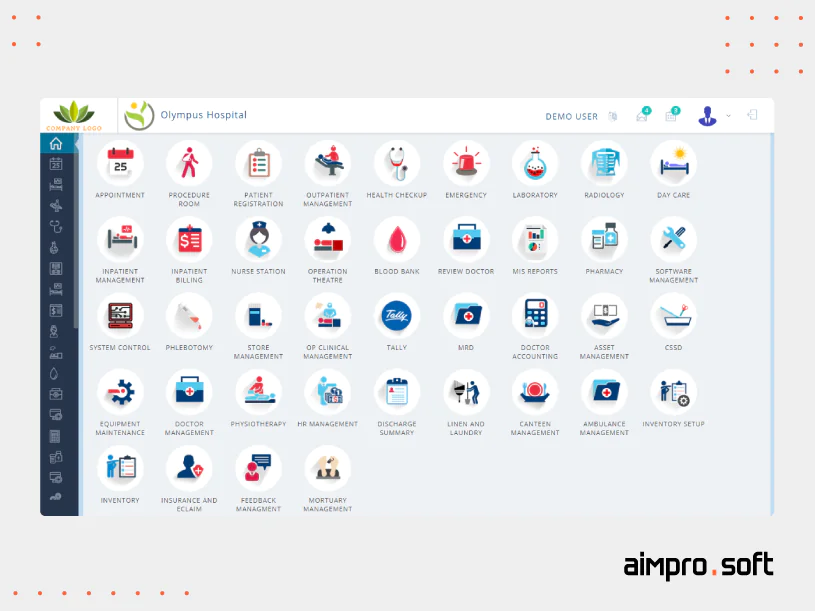
Interface of the eHospital Management Software. Source: Sourceforge
Since 2008, the American company Adroit Infosystems has been proposing eHospital — a complete SaaS product for medical organizations. Over 12 years, the campaign has done a great job of studying user feedback to exceed customers’ expectations.
eHospital is considered one of the best HMS software on the market among hospitals. The product is known for its high degree of customization, stable operation, reputation, and a wide list of features:
- Inpatient and outpatient management;
- Online appointment scheduling;
- Portal for doctors;
- Portal for patients;
- Billing system;
- Accounting;
- Inventory control;
- Security management.
If you’re also interested in developing a SaaS platform, read our article on the subject to find out more.
SoftClinic
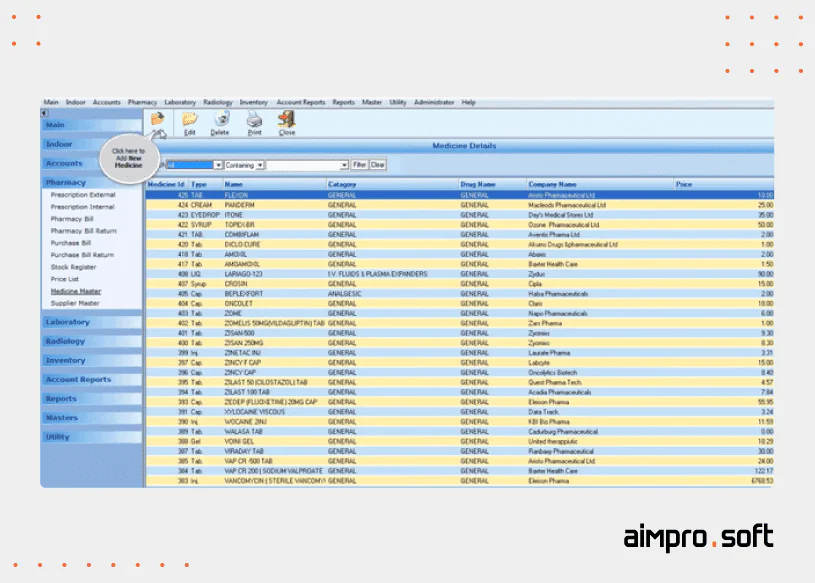
Interface of the SoftClinic HMS. Source: Softwareconnect
SoftClinik was established in 2002 as EHR and HMS by the Indian company JVS Group. It includes the Hospital Information System (HIS), EHR, and a portal for patients where they can store medical records. SoftClinic is available for PC, web, and mobile platforms, but for the latter, there is no official support, which is a significant drawback.
The main SoftClinic features include:
- Appointment Scheduling;
- Bed Management;
- Claims Management;
- Inpatient and outpatient management;
- Inventory Management;
- Medical Billing;
- Patient Records Management;
- Physician Management;
- Policy Management.
Medstar HIS
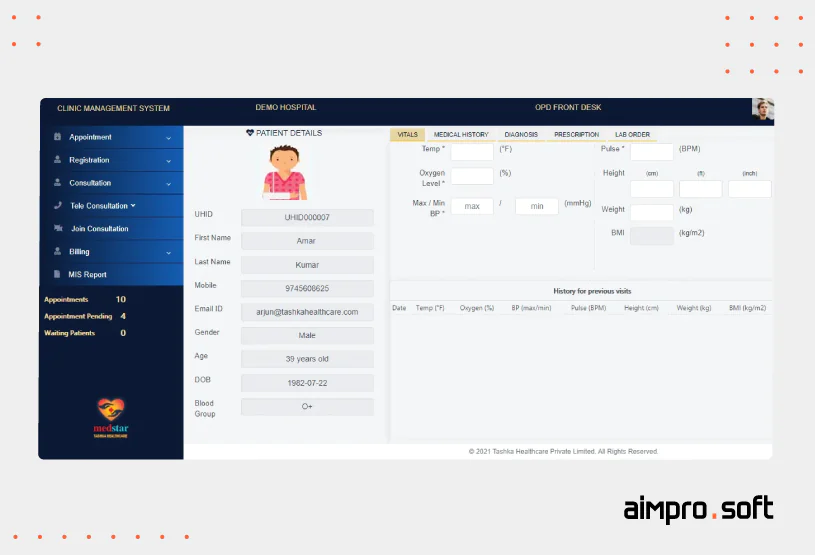
The interface of the SoftClinic HMS. Source: Sourceforge
The third one from the HMS list, which came out of the digital workshop of Pinaacle Technologies, Medstar HIS, offers customers more than 50 premium modules and features that many other competitors don’t have:
- EMR module allows storing any information on the online portal — from laboratory tests to doctors’ recommendations;
- keeps billing records in compliance with industry standards;
- advanced storage and backup facilities protect against any data loss.
Medstar HIS does not have a free trial, unlike the rest of the HMS on our list. It supports all possible platforms, and its price starts at $250 per month.
How to create a custom hospital management software?
Building customized software for hospitals includes a systematic approach to ensure the successful development and implementation of a tailor-made solution. Every step 一 from finding a reliable vendor and preparing the statement of work (SoW) to developing an intuitive interface and ensuring compliance with HIPAA/HITECH regulations, plays a crucial role in creating a system that meets the unique requirements of a healthcare facility. In this section, we take an in-depth look at all the key steps to help you successfully go through the process and create the optimal system for your organization.
Find a vendor
To create a hospital management system, you need to begin with the selection of a suitable vendor for your product. You can determine the qualifications of the software company by viewing its website and studying the portfolio. An experienced development company with similar projects under the belt and sufficient resources will be the best choice to work on your project.
Prepare a Statement of Work (SoW)
After you have contacted the hospital software development company, pay attention to the statement of work formulation, where technical documentation and a list of features are determined. The development team reads the SoW and creates an estimate of the project. Often at this stage, bilateral negotiations arise to clarify all the necessary points until both sides reach a consensus.
Make an intuitive design
To provide a complete picture of the visual side of your software, UI/UX engineers design hospital management system wireframes and mockups to display the future interface, which is a major part of any HMS. The interface design should be intuitive and functional for both hospital staff and patients; therefore, more time has to be devoted primarily to user experience.
Responsive hospital management software design will also require the creation of a few different user interfaces for ease of use. To achieve it, you can develop an Android/iOS mobile application or build a responsive site using frameworks like Bootstrap, React, Angular, or Vue.js.
Follow HIPAA/HITECH rules
Keep in mind that before coming directly to development, you must be sure you meet numerous safety standards to make a hospital management system software properly. If we are talking about the USA, this is primarily HIPAA (Health Insurance Portability and Accountability Act)/HITECH (Health Information Technology for Economic and Clinical Health), and FDA (Food and Drug Administration) compliance.
If we consider Europe, this is the first and foremost GDPR (General Data Protection Regulation) law you should obey. Obtaining certification imposes certain restrictions on software development or even penalties for violations, such as huge fines and/or imprisonment.
Choose an appropriate tech stack and think over the architecture
As the HMS programming language, we recommend choosing Java or .NET. Other languages, such as Node.js, are more lightweight and may not withstand heavy loads. MySQL or PostgreSQL is suitable for the database if your solution is local and applies in one hospital. If you plan to support a certain number of hospitals at once, you should choose a more powerful technology, like Oracle. If you can’t afford Oracle, you can use Postgr; therefore, other databases support clustering.
One of the must-have requirements for HMS is availability 24/7. To do this, use the load balancers and ensure that when you turn off a particular module, the entire system does not fall after that. The architecture of your system should be modular, and its components have to be constantly monitored. Finally, don’t forget to have backups for restoring the system in any unexpected situation.
Achieve reliable system security
Since the healthcare industry is characterized by a large movement of confidential information and an obligation to comply with numerous regulations, developers should build the system with the highest possible data safety guarantee. If you can afford it, we recommend using cloud solutions such as Amazon Web Services, Microsoft Azure, or Google Cloud Platform. If the budget is limited, it will be stored on your own computers with backups. You can achieve system security by:
- ensuring the creation of strict role-based access;
- conducting thorough QA tests to prevent data loss during hacker attacks.
Let’s look at our case study in more detail to find out how to make a hospital management software.
A case from our portfolio: Healthcare provider portal
A year ago, a customer from Italy contacted us about the healthcare project. The idea was to develop a hospital management software — a portal for the interaction between doctors and patients.
Our developers chose Liferay DXP 7.1 as a basis for the portal. According to the hospital’s structure, 2 custom roles were created, and the hospital management system content changed depending on what role the user used. The main goal of the portal was the generation and conclusion of contracts between a doctor and a patient.
We enabled its work as follows: the patient made a request for a document, and filled out a special form, after which a PDF contract was automatically generated, which was viewed and signed through integration with the external library. E-signature feature provided the generation of a PDF contract. For the convenience of users, documents were sorted by signed/unsigned criteria.
Within 5 months, our team of 3 developers completed the Liferay portal creation, and the customer received a high-quality website with more than 2000 entries per day.
Fill in the contact form, making a first step towards developing the best solution for your needs.
CONTACT USHow much does it cost to develop a hospital management system?
So, we already know how to make a hospital management software. But the question of price is no less important. The cost of any HMS is purely individual and depends on its functionality and customer requirements. We will calculate both solutions: the first similar to our Liferay case, and the other one — how to build an online clinic management system from scratch.
Let’s start with the above-described Liferay Health Care Provider Portal with OOTB functionality.
Liferay case cost
Healthcare Provider Portal case contained such a list of features, on the basis of which we will evaluate the full estimate:
- Liferay DXP 7.1;
- Liferay customization;
- Implementation of e-signature;
- Role-based access control;
- Advanced search for doctors;
- Advanced search for patients;
- PDF document generation.
To implement such functionality, you will need the following development team:
- 1 Project manager;
- 1 UI/UX engineer;
- 2 Liferay developers;
- 1 Frontend developer;
- 1 QA engineer.
Liferay provides a ready-made platform with standard functionality that our developers can reuse and add the features you may need. Both Business analysis and Technical specifications will take about a week. UI/UX will require 40-50 hours to create a hospital management software design. The development phase of the portal will take about 500 hours, and 70-90 hours will be devoted to QA. Based on the set functionality and development team, we can give the following cost of such kind of project:
| Stages | Full-fledged solution ~580—680 hours |
|---|---|
| Business analysis | 10—20 |
| Technical specification | 10—20 |
| UI/UX | 40—50 |
| Development | 450—500 |
| QA | 70—90 |
On the ground of the calculated development hours, you can confidently determine the cost of creating a full-fledged solution. The US and UK have the highest rates, with developers’ work priced at $95 and $80 per hour, respectively. Western Europe (e.g., Germany) is distinguished by a lower price, while Eastern Europe (e.g., Ukraine) has rates of $35 for engaging highly-qualified developers for the project.
| Country | Average hourly rate | Full-fledged solution ~580—680 hours |
|---|---|---|
| USA | $95-105 | $55,100 一 64,600 |
| Western Europe (Germany) | $65-75 | $37,700 — 44,200 |
| UK | $80-90 | $46,400 一 54,400 |
| Eastern Europe (Ukraine) | $35-55 | $23,200 一 27,200 |
Hospital management system MVP cost
We provide an MVP estimate because a full-featured product can vary from hospital to hospital beyond recognition, depending on their goals and requirements. In this case, it is extremely difficult to determine the approximate dates and costs of development. At the same time, MVP is a web product with the minimum necessary functionality for full work. We highlight the following list of primary features for hospital software system MVP:
- Patient registration and scheduling;
- Patient records management;
- Financial management;
- Data reports and statistics;
- Search;
- Inventory management;
- Supply management.
To develop a hospital management system with such a set of functionality, you will need the following team:
- 1 Project manager;
- 1 Tech Lead;
- 2 Backend developers;
- 1-2 Frontend developers;
- 1 UI/UX engineer;
- 2 QA engineers.
When you want to build a hospital management system, remember, it is a large-scale deal, which is already evident at the stage of Business analysis and Technical specification — often, they take more than a month. On the shoulders of UI/UX engineers lies the task of making a responsive user interface design for both patients and doctors, which takes no less than 100 hours. Frontend development takes about 400 hours on average, and the backend consumes 700-1000. To ensure optimal quality and high-level security of the system, we recommend you devote to QA tests at least 40% of the total development time.
| Stages | MVP hours ~1850—2500 |
|---|---|
| Business analysis | 140—160 |
| Technical specification | 60—100 |
| UI/UX | 100—140 |
| Frontend development | 400—500 |
| Backend development | 700—1000 |
| QA | 450—600 |
Based on these hours, we can determine the cost of hospital management system software development:
| Country | Hourly rates | MVP ~1850—2500 hours |
|---|---|---|
| USA | $95-105 | $175,750 一 262,500 |
| Western Europe (Germany) | $65-75 | $120,250 — 187,500 |
| UK | $80-90 | $148,000 一 225,000 |
| Eastern Europe (Ukraine) | $35-55 | $64,750 一 137,500 |
Please note that to get the cost of a full-fledged product, you should add complementary features you may require to the MVP version given above and count the hours on their development.
Also, consider the terms for passing HIPAA/HITECH certification, which can take up to several years, depending on your organization’s type, size, and IT environment. If you want to add a mobile platform in addition to the desktop application, it will take extra time and spending.
Conclusion
More and more hospitals are transforming their business processes into digital infrastructure.
The hospital database management system sets in motion the optimization of a healthcare organization’s workflow and data operations. Whether you want to use a ready-made solution for your hospital or build an online clinic management system from scratch, contact us to get your dream product.
FAQ
Which software process model is best for a hospitals management system?
When considering a software process model for a hospital management system, several options may be appropriate, depending on the project’s specific requirements. Here are three popular examples: Agile 一 the software process model promotes flexibility, adaptability, and frequent feedback, essential in the rapidly evolving healthcare industry. An incremental model 一 like Agile involves total development and delivery of software modules to achieve regular releases and user feedback. The waterfall model 一 a sequential approach with distinct phases, ideal for projects with well-defined requirements and few changes.
What are the core features of hospital system software?
Software for hospitals often includes features such as staff management and scheduling, electronic prescribing, integrated communication systems, a patient portal for self-service and access to health information, integration with medical equipment, and interoperability with other strategies for seamless data exchange. It may also have modules for specific departments like radiology, pathology, and emergency, as well as features for data security and compliance with regulatory standards like HIPAA.
What are the main benefits of building hospital management software?
Hospital management software offers many benefits, including streamlined administrative processes and improved patient care. It also enables efficient patient registration, appointment scheduling, and billing, reducing paperwork and administrative errors. Electronic health records (EHR) centralize patient data, improving the ability to track treatment.
Why is an HMS (hospital management system) required?
A hospital management program is essential for clinics to manage their operations effectively. Robust reporting and analytics capabilities provide valuable insights for informed decision-making, leading to improved resource allocation. Digitalization also plays a crucial role in ensuring data security. By moving from paper-based records to digital platforms, healthcare organizations can gain access to features that protect sensitive patient data.
What type of medical practice management software is best?
The choice of the best type of medical practice management software depends on the specific needs and requirements of the practice. There are types, such as all-in-one, specialty-specific, cloud-based, and standalone billing systems. Integrated all-in-one systems offer many functions and are suitable for medium- and large-sized clinics. Specialized systems meet the unique needs of specific medical specialties.
Cloud-based systems provide availability, scalability, and cost-effectiveness. Standalone billing systems focus on billing and revenue cycle management. One important thing to remember is that to choose the best software, you must first rely on your organization’s specific needs.




